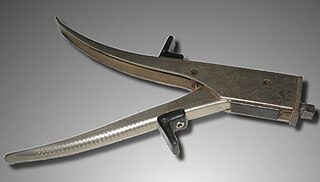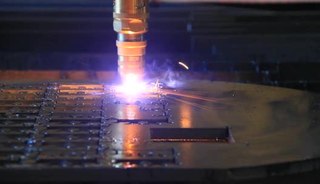Related Research Articles
A crusher is a machine designed to reduce large rocks into smaller rocks, gravel, sand or rock dust.

Hydraulic rescue tools, also known as jaws of life, are used by emergency rescue personnel to assist in the extrication of victims involved in vehicle accidents, as well as other rescues in small spaces. These tools include cutters, spreaders, and rams. Such devices were first used in 1963 as a tool to free race car drivers from their vehicles after crashes.

A nibbler, or nibblers, is a tool for cutting sheet metal with minimal distortion. They may be used for nibbling. One type operates much like a punch and die, with a blade that moves in a linear fashion against a fixed die, removing small bits of metal and leaving a kerf approximately 6 mm (0.24 in) wide. Another type operates similar to tin snips, but shears the sheet along two parallel tracks 3–6 mm (0.12–0.24 in) apart, rolling up the waste in a tight spiral as it cuts. Nibblers may be manual or powered.

A bandsaw is a power saw with a long, sharp blade consisting of a continuous band of toothed metal stretched between two or more wheels to cut material. They are used principally in woodworking, metalworking, and lumbering, but may cut a variety of materials. Advantages include uniform cutting action as a result of an evenly distributed tooth load, and the ability to cut irregular or curved shapes like a jigsaw. The minimum radius of a curve is determined by the width of the band and its kerf. Most bandsaws have two wheels rotating in the same plane, one of which is powered, although some may have three or four to distribute the load. The blade itself can come in a variety of sizes and tooth pitches, which enables the machine to be highly versatile and able to cut a wide variety of materials including wood, metal and plastic.

Ship-breaking is a type of ship disposal involving the breaking up of ships either as a source of parts, which can be sold for re-use, or for the extraction of raw materials, chiefly scrap. Modern ships have a lifespan of 25 to 30 years before corrosion, metal fatigue and a lack of parts render them uneconomical to operate. Ship-breaking allows the materials from the ship, especially steel, to be recycled and made into new products. This lowers the demand for mined iron ore and reduces energy use in the steelmaking process. Fixtures and other equipment on board the vessels can also be reused. While ship-breaking is sustainable, there are concerns about its use by poorer countries without stringent environmental legislation. It is also labour-intensive, and considered one of the world's most dangerous industries.

Scrap consists of recyclable materials, usually metals, left over from product manufacturing and consumption, such as parts of vehicles, building supplies, and surplus materials. Unlike waste, scrap has monetary value, especially recovered metals, and non-metallic materials are also recovered for recycling. Once collected, the materials are sorted into types — typically metal scrap will be crushed, shredded, and sorted using mechanical processes.

Plasma cutting is a process that cuts through electrically conductive materials by means of an accelerated jet of hot plasma. Typical materials cut with a plasma torch include steel, stainless steel, aluminum, brass and copper, although other conductive metals may be cut as well. Plasma cutting is often used in fabrication shops, automotive repair and restoration, industrial construction, and salvage and scrapping operations. Due to the high speed and precision cuts combined with low cost, plasma cutting sees widespread use from large-scale industrial computer numerical control (CNC) applications down to small hobbyist shops.

Sheet metal is metal formed into thin, flat pieces, usually by an industrial process.

A tree chipper or woodchipper is a machine used for reducing wood into smaller woodchips. They are often portable, being mounted on wheels on frames suitable for towing behind a truck or van. Power is generally provided by an internal combustion engine from 2 to 700 kilowatts. There are also high power chipper models mounted on trucks and powered by a separate engine. These models usually also have a hydraulic winch.

A punch press is a type of machine press used to cut holes in material. It can be small and manually operated and hold one simple die set, or be very large, CNC operated, with a multi-station turret and hold a much larger and complex die set.

A pipecutter is a type of tool used by plumbers to cut pipe. Besides producing a clean cut, the tool is often a faster, cleaner, and more convenient way of cutting pipe than using a hacksaw, although this depends on the metal of the pipe.

A blowout preventer (BOP) is a specialized valve or similar mechanical device, used to seal, control and monitor oil and gas wells to prevent blowouts, the uncontrolled release of crude oil or natural gas from a well. They are usually installed in stacks of other valves.

Honing is an abrasive machining process that produces a precision surface on a metal workpiece by scrubbing an abrasive grinding stone or grinding wheel against it along a controlled path. Honing is primarily used to improve the geometric form of a surface, but can also improve the surface finish.

Blanking and piercing are shearing processes in which a punch and die are used to produce parts from coil or sheet stock. Blanking produces the outside features of the component, while piercing produces internal holes or shapes. The web is created after multiple components have been produced and is considered scrap material. The "slugs" produced by piercing internal features are also considered scrap. The terms "piercing" and "punching" can be used interchangeably.

A screw press is a type of machine press in which the ram is driven up and down by a screw. The screw shaft can be driven by a handle or a wheel. It works by using a coarse screw to convert the rotation of the handle or drive-wheel into a small downward movement of greater force. The overhead handle usually incorporates balls as flyweights. The weights helps to maintain the momentum and thrust of the tool to make it easier to operate.

A car crusher is an industrial device used to reduce the dimensions of derelict (depreciated) cars prior to transport for recycling.

An industrial shredder is a machine used to break down materials for various applications such as recycling, volume reduction, and product destruction. Industrial shredders come in many different sizes and design variations based on what particle size is needed for final shredded product.
There are many types of shears used to shear or cut sheet metal.
Press tools are commonly used in hydraulic, pneumatic, and mechanical presses to produce the sheet metal components in large volumes. Generally press tools are categorized by the types of operation performed using the tool, such as blanking, piercing, bending, forming, forging, trimming etc. The press tool will also be specified as a blanking tool, piercing tool, bending tool etc.
A scrap metal shredder, also sometimes referred to as a metal scrap shredder, is a machine used for reducing the size of scrap metal. Scrap metal shredders come in many different variations and sizes.
References
- ↑ International Textbook Company (1906), International Library of Technology, vol. 123, International Textbook Company, p. 27.
- ↑ Gale, Walter Keith Vernon (1971). "crocodile shear". The iron and steel industry: a dictionary of terms. David and Charles. p. 57.
- ↑ Mazzolani, Federico M.; Ivʹanyi, M. (2002), Refurbishment of buildings and bridges, Springer, p. 267, ISBN 978-3-211-83690-3 .
- 1 2 Lund, Herbert F. (2001), The McGraw-Hill recycling handbook (2nd ed.), McGraw-Hill Professional, p. 28.20, ISBN 978-0-07-039156-7 .